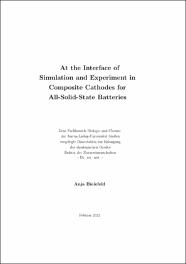| dc.description.abstract | In the course of the exit from nuclear and fossil-fuel energy and the transformation of the mobility sector, batteries gain in importance. With their potentially high energy density, and high range for battery electric vehicles, accordingly, (all-)solid-state batteries are a possible alternative to conventional lithium ion batteries. These contain liquid, flammable electrolytes and solvents that are, in solid-state batteries, substituted by a solid ion conductor whose lower flammability could also offer safety relevant advantages.
To date, solid-state batteries are not available in mass production and exhibit partly extensive differences in capacity and performance compared to conventional cells. A fundamental differ- ence in the cell concept is the particle morphology of the solid electrolytes: Highly conductive materials, such as lithium argyrodites (e.g. Li6PS5Cl) are counted among the glass-ceramics and possess a specific microstructure. Therefore, it is not possible to infiltrate porous electrode structures that contain the ion storage material (active material), with the electrolyte. Instead, the solid electrolyte has to be considered already upon electrode manufacturing. Moreover, also composites that feature a comparably ductile solid electrolyte have residual void space and the role of these voids and the electrode microstructure in solid-state batteries is barely understood and studied.
Indeed, several questions that concern the microstructure are difficult to address in experimental work. Hence, this dissertation regards the electrode microstructure from the perspective of mod- eling and simulation and studies the conduction networks through the electrode, their effectivity and the charge behavior of synthetically generated realistic microstructures in different model approaches.
The electrode models consist of cathode active material, solid electrolyte and void space which are reconstructed with their characteristic shapes and sizes based on scanning electron microscope images. The model complexity increases in the course of the thesis, beginning with an analysis of the lithium ion and electron percolation through the electrode which depicts that small cathode active material particles are favorable in forming percolating electron networks due to their high surface area. The work leads to the simulation of the electrochemical processes in the cathode, therein portraying the coaction of experiments and simulations and zooms in on the interface of the active material and the voids. Further, aspects of mass production, such as the effects of binders that are required for roll-to-roll processing and the (laser-)structuring of electrodes, are discussed in the thesis. The simulation outcomes identify trade-offs in the electrode design and are used to develop guidelines, consequently. | de_DE |



